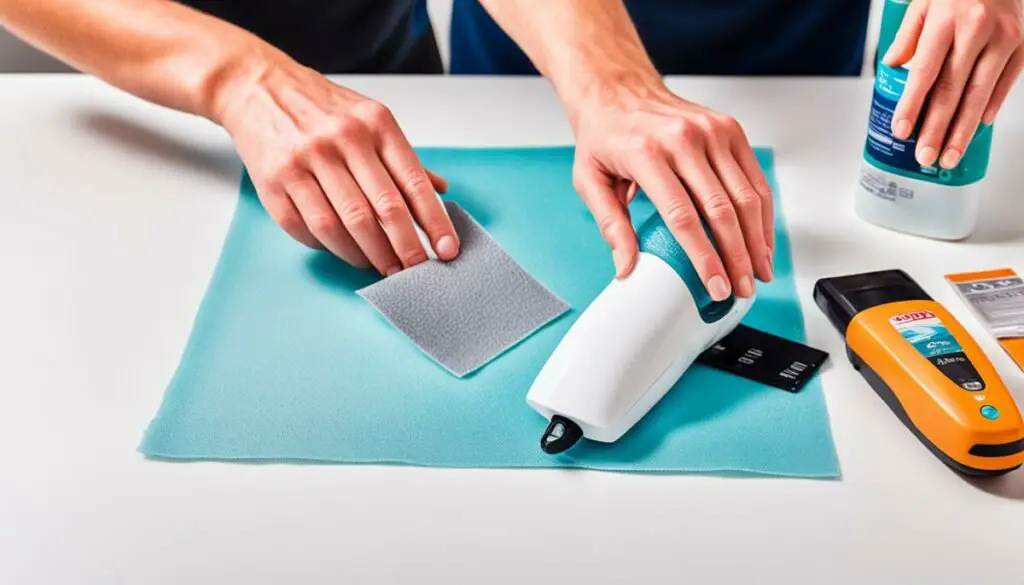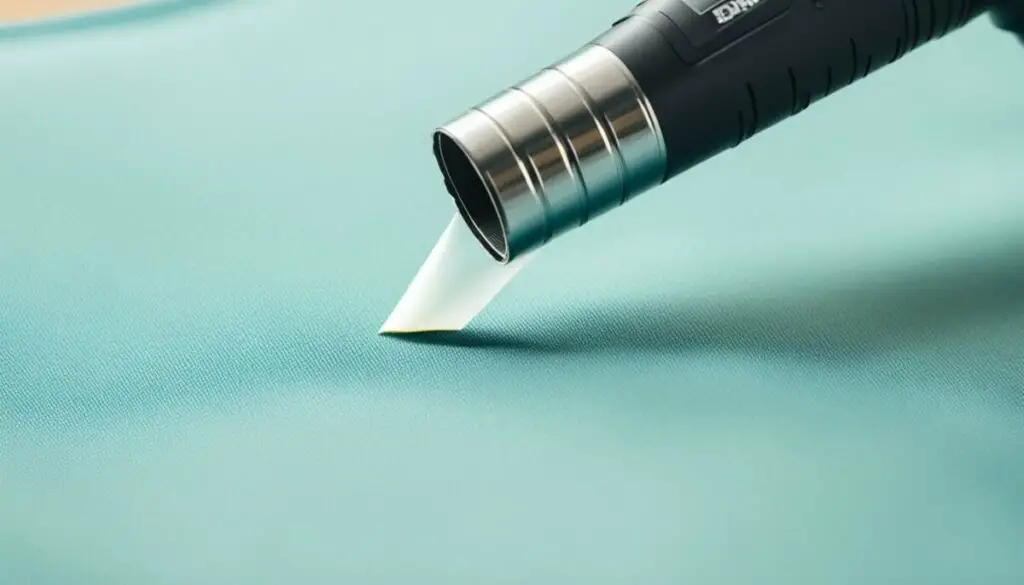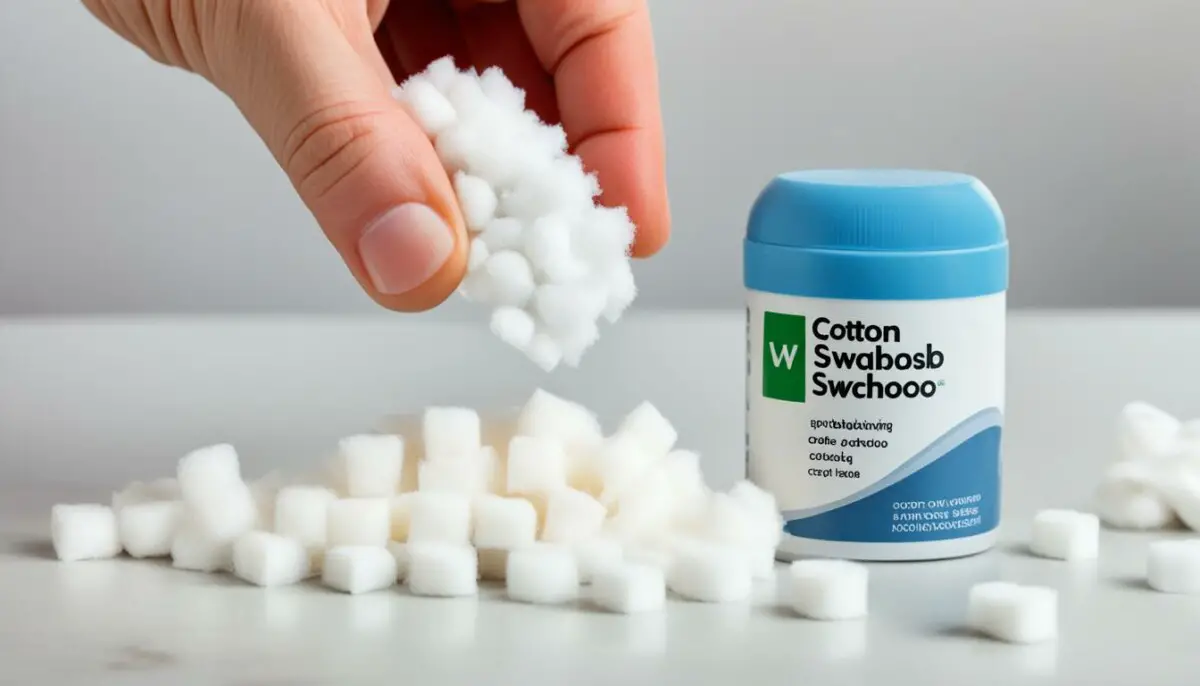Last Updated on 3 months by Francis
Velcro is a popular hook and loop fastener used in various products. However, removing the Velcro adhesive can be a challenge, and it often leaves behind sticky residue. In this article, we will explore easy and effective tips and tricks to remove Velcro glue and eliminate any residue left behind.
Contents
Key Takeaways:
- Removing Velcro glue can be done with the right techniques and solutions.
- Choose the appropriate method based on the surface, such as heat, chemicals, or natural remedies.
- Test the chosen method in a small area to avoid damage or stains.
- Be cautious and avoid overheating when using heat to remove Velcro adhesive.
- Gentle scraping with suitable tools can help remove the residue effectively.
Different Substrates and Removal Techniques

Removing Velcro adhesive depends on the substrate it is applied to. Different substrates like metal, glass, painted surfaces, plastics, and drywall require different removal techniques. It’s important to choose the right technique based on the substrate to avoid causing damage or stains.
For surfaces like painted walls and plastics, heat can be used to loosen the adhesive. Applying heat with a blow dryer or heat gun softens the adhesive, making it easier to scrape off. However, caution is advised to prevent overheating and damaging the surface.
On the other hand, glass and metal surfaces may benefit from scraping and using solvents or alcohol. Gentle scraping with a putty knife or an old credit card helps remove the adhesive, while solvents or alcohol break down the glue residue. Always be cautious and test the chosen solvent on a small area before applying it to the entire surface.
Using Heat to Loosen the Adhesive

When it comes to removing Velcro adhesive, applying heat can be an effective technique. By using a blow dryer or heat gun, you can soften the adhesive, making it easier to scrape off. This method is especially useful for painted surfaces and plastics.
Here’s how you can use heat to remove Velcro glue:
- Prepare the area: Start by clearing the surface from any debris or loose particles. This will ensure a clean removal process.
- Apply heat: Hold the blow dryer or heat gun a few inches away from the adhesive. Move it in a back-and-forth motion to evenly distribute the heat. Be cautious not to overheat the surface, as it can cause damage to certain materials.
- Scrape off the adhesive: As the adhesive softens, use a plastic scraper or an old credit card to gently scrape off the residue. Be careful not to apply too much pressure to avoid scratching or damaging the surface.
- Clean the area: Once the adhesive is removed, wipe down the area with a clean cloth dampened with warm water and mild detergent to remove any remaining residue.
Using heat to loosen the adhesive can make the removal process a breeze. Just remember to be cautious and avoid overheating the surface to prevent any unintended damage.
To give you a visual guide, here’s an image demonstrating the use of heat to remove Velcro adhesive:
| Advantages of Using Heat: | Disadvantages of Using Heat: |
|---|---|
|
|
Chemical Solutions for Adhesive Removal

When it comes to removing Velcro adhesive residue, exploring chemical solutions can be quite effective. Various chemicals, such as solvents, alcohol, oils, acetone, and commercial adhesive removers, can break down and remove the sticky residue from different surfaces.
However, it is important to exercise caution and follow best practices to prevent any damage or stains on the surface. Always check if the chosen chemical solution is suitable for the specific substrate.
Before applying the chemical solution to the entire surface, test it in a small and inconspicuous area to ensure compatibility and avoid any potential harm or discoloration.
Remember to work in a well-ventilated area when using chemicals to ensure your safety throughout the process.
Using the right chemical solution can be a practical and efficient method for removing Velcro adhesive residue. Now let’s delve deeper into different chemical solutions and their applications.
DIY Adhesive Removers

In addition to commercial adhesive removers, you can use several DIY solutions to effectively remove Velcro adhesive. These homemade remedies are not only cost-effective but also readily available in most households. Let’s explore some of the popular DIY adhesive removers:
1. Hot Water with Dishwashing Liquid
A simple mixture of hot water and dishwashing liquid can work wonders in removing Velcro glue residue. Soak the affected area in this solution for a few minutes to loosen the adhesive. Then, gently scrub the residue with a soft cloth or sponge. Rinse with clean water and pat dry.
2. Vinegar
“Vinegar is a natural adhesive remover that can effectively break down Velcro glue.”
Apply vinegar directly to the adhesive residue and let it sit for a few minutes. Use a cloth or sponge to scrub the area gently. Vinegar works well on glass, tile, and countertops, but avoid using it on rubber, stone, or wood surfaces.
3. Coconut Oil and Baking Soda Paste
Create a paste by mixing equal parts coconut oil and baking soda. Apply this paste to the adhesive residue and let it sit for around 10-15 minutes. The combination of coconut oil and baking soda helps break down the adhesive. Use a cloth or sponge to scrub the area and wipe off the residue.
4. Rubbing Alcohol
Rubbing alcohol is an effective adhesive remover, especially on hard surfaces like plastic or metal. Moisten a cloth or cotton ball with rubbing alcohol and gently rub the adhesive residue. Repeat as needed until the residue is completely removed.
Remember to test these DIY adhesive removers on a small, inconspicuous area before using them on the entire surface to ensure they don’t cause any damage or discoloration.
Scrape Away the Adhesive

Once the adhesive has been softened, it’s time to gently scrape away the residue. There are several tools you can use for this task, depending on your preference and the surface you are working on. Here are some options:
- Putty knives: These flat, flexible tools are perfect for carefully scraping off the adhesive without causing any damage.
- Old credit cards: If you don’t have a putty knife, an old credit card can be a great alternative. Its smooth edge helps to remove the residue effectively.
- Fingernails: In some cases, you can use your fingernails to gently lift and scrape off the adhesive. Make sure your nails are clean to prevent any additional residue from transferring to the surface.
- Old toothbrushes: An old toothbrush with stiff bristles can be useful for scrubbing away the remaining adhesive, especially in tight areas or textured surfaces.
When scraping away the adhesive, be cautious and remember to apply gentle pressure to avoid damaging the surface. Additionally, if the residue is still stubborn, you can try directing some heat onto it using a hairdryer. The heat will further soften the adhesive, making it easier to scrape off.
| Tools for Scrapping Adhesive | Pros | Cons |
|---|---|---|
| Putty knives | Effective for removing adhesive without causing damage. | May not be suitable for small or narrow areas. |
| Old credit cards | Smooth edge helps to scrape off residue. | Not as sturdy as putty knives. |
| Fingernails | Can be used in a pinch and readily available. | May not be suitable for larger areas or thick residue. |
| Old toothbrushes | Useful for scrubbing away adhesive in tight areas. | May not be effective for heavy residue or large surfaces. |
How to Remove Velcro Adhesive from Different Surfaces

The process of removing Velcro adhesive may vary depending on the surface. Here are some effective methods for removing sticky Velcro glue residue:
- For fabric or cloth: Soak the area in hot water with dishwashing liquid. This will help soften the adhesive, making it easier to remove. Scrub gently with a soft brush or cloth to remove any remaining residue.
- For glass, countertops, and tile: Rubbing alcohol can be an effective solution. Apply a small amount to a clean cloth or sponge and gently rub the adhesive residue until it is removed. Rinse with water and dry the surface thoroughly.
- For rubber, stone, or wood surfaces: Avoid using vinegar as it can potentially damage these surfaces. Instead, use a gentle cleaning solution recommended for the specific material, following the manufacturer’s instructions.
- For wood and metal surfaces: Sandpaper can be used to gently remove the adhesive residue. Start with a fine-grit sandpaper and lightly sand the affected area until the residue is gone. Wipe the surface clean with a damp cloth afterward.
- For skin: If Velcro adhesive has accidentally stuck to your skin, apply a mixture of coconut oil and baking soda paste to the affected area. Let it sit for a few minutes, then gently scrub and rinse with water.
Remember to always test the chosen method on a small, inconspicuous area first to ensure it doesn’t cause any damage to the surface. Additionally, be patient and gentle during the removal process to avoid any unwanted scratches or marks.
| Surface Type | Recommended Removal Method |
|---|---|
| Fabric or Cloth | Soak in hot water with dishwashing liquid, scrub gently with a soft brush or cloth |
| Glass, Countertops, and Tile | Rubbing alcohol, applied with a clean cloth or sponge |
| Rubber, Stone, or Wood | Avoid vinegar, use gentle cleaning solution recommended for the specific material |
| Wood and Metal | Gently sand with fine-grit sandpaper, wipe clean |
| Skin | Coconut oil and baking soda paste, followed by gentle scrub and rinse |
Precautions and Tips
When removing Velcro adhesive, it’s important to take precautions and follow some tips. Here are some key guidelines to ensure a safe and effective velcro adhesive removal process:
- Always test the chosen removal method on a small, inconspicuous area first. This step helps you determine whether the method will cause any damage or leave stains on the surface.
- Work in a well-ventilated area when using chemicals. Proper ventilation ensures you have a constant flow of fresh air and minimizes the risk of inhaling any harmful fumes.
- Be cautious when using heat to remove Velcro adhesive. Overheating the surface can lead to damage and discoloration. Use low or moderate heat settings and keep a safe distance between the heat source and the surface being treated.
- When scraping off the adhesive residue, be gentle to avoid causing any surface damage. Use tools such as putty knives, old credit cards, or old toothbrushes to effectively remove the residue without scratching or denting the surface.
Tip: If you’re unsure about the best method or concerned about potential damage, consult a professional or seek advice from the manufacturer or supplier of the surface or product you’re working with.
Example: Precautions When Using Chemical Solvents
If you decide to use chemical solvents for adhesive removal, it’s essential to keep the following precautions in mind:
- Read and follow the instructions provided by the manufacturer of the adhesive remover. Different products may have specific application and safety instructions.
- Wear protective gloves to prevent skin contact with the chemical solvent. Some solvents can be harsh and irritate the skin.
- Perform the adhesive removal process in a well-ventilated area to minimize exposure to fumes.
- Avoid using chemical solvents near open flames or in areas with poor ventilation, as they can be flammable.
- If you accidentally spill a chemical solvent, clean it up immediately to prevent it from spreading or causing further damage.
By taking these precautions and following the provided tips, you can safely and effectively remove Velcro adhesive without causing harm to the surfaces you’re working with.
| Precautions | Tips |
|---|---|
| Always test removal method on a small area | Work in a well-ventilated area |
| Be cautious when using heat | Be gentle while scraping |
| Example: Precautions When Using Chemical Solvents | |
| Read and follow instructions carefully | Wear protective gloves |
| Perform removal in a well-ventilated area | Avoid open flames or poor ventilation |
| Clean up spills immediately | |
Commercial Adhesive Removers
If your DIY methods for removing Velcro adhesive are not effective or if you have a specific issue that requires a tailored solution, there are several commercial adhesive removers available that can help you get the job done. These products have been specially formulated to dissolve and remove adhesives, including those used in Velcro.
Here are a few popular options:
- Goo Gone: Goo Gone is a trusted adhesive remover that effectively breaks down sticky residues. It is safe to use on a variety of surfaces, including metal, glass, plastic, and painted surfaces.
- WD-40: WD-40 is a versatile product that can be used for many purposes, including removing adhesive residues. Spray it onto the sticky area, let it sit for a few minutes, and then wipe away the residue.
- Smith & Nephew UNI-SOLVE Adhesive Remover: This adhesive remover is commonly used in healthcare settings to remove medical adhesives and tapes. It is gentle on the skin and can also be effective in removing Velcro adhesive.
When using commercial adhesive removers, it’s important to follow the instructions provided by the manufacturer. Test the product on a small, inconspicuous area before applying it to the entire surface to ensure compatibility and avoid any potential damage. Always work in a well-ventilated area and take appropriate safety precautions.
Remember, different adhesive removers may be more effective on specific surfaces or types of adhesive residue. If one product doesn’t work for you, don’t hesitate to try another until you find the best solution for your needs.
Natural Adhesive Removers
For those who prefer natural solutions, there are several options for removing Velcro adhesive. Mixtures of baking soda and cooking oil, diluted white vinegar, or coconut oil can be used as natural adhesive removers. These alternatives are cost-effective and generally safe for most surfaces. However, it’s still essential to test these solutions on a small area first to avoid any potential damage.
Removing Velcro adhesive residue can be achieved using natural adhesive removers. Here are some common natural solutions:
- Mix baking soda and cooking oil to create a paste. Apply the paste to the adhesive residue, let it sit for a few minutes, and then gently rub it off.
- Dilute white vinegar with water and apply it to the adhesive residue. Let it sit for a few minutes, then wipe it away with a soft cloth.
- Apply coconut oil directly to the adhesive residue and let it soak for a few minutes. Use a soft cloth to wipe away the residue.
These natural adhesive removers are effective at breaking down the Velcro glue and removing the sticky residue. They are safe to use on most surfaces, but it’s always a good idea to test them on a small, inconspicuous area first to ensure they don’t cause any damage or discoloration.
Benefits of Natural Adhesive Removers
Natural adhesive removers offer several benefits:
- Cost-effective: Most natural adhesive removers can be made with ingredients commonly found at home, making them an affordable option.
- Eco-friendly: Natural solutions are free from harsh chemicals that may harm the environment.
- Safe for most surfaces: Natural adhesive removers are generally gentle and safe to use on various surfaces, including fabrics, metals, plastics, and glass.
However, it’s important to note that natural adhesive removers may not be as strong as commercial products. Therefore, stubborn or heavily-adhered Velcro glue may require alternative removal methods.
Comparison of Natural Adhesive Removers
| Adhesive Remover | Main Ingredients | Surface Suitability |
|---|---|---|
| Baking Soda and Cooking Oil | Baking soda, cooking oil | Most surfaces, including fabrics, plastics, metals |
| Diluted White Vinegar | White vinegar, water | Glass, metals, plastics, countertops |
| Coconut Oil | Coconut oil | Most surfaces, including fabrics, plastics, metals |
Conclusion
Removing Velcro glue and eliminating adhesive residue can be easily achieved with the right techniques and solutions. Whether using heat, chemicals, or natural remedies, it’s important to choose the appropriate method based on the surface and take precautions to avoid any damage.
By following the tips and tricks mentioned in this article, you can successfully remove Velcro adhesive and enjoy clean surfaces once again. Remember to test any chosen removal method on a small, inconspicuous area before applying it to the entire surface.
Whether you opt for DIY solutions or commercial adhesive removers, always prioritize safety and take necessary precautions. With patience and the right approach, you can effectively remove Velcro glue and achieve a pristine look on various substrates without any residue remaining.
FAQ
What is Velcro adhesive and why is it difficult to remove?
Velcro adhesive is the sticky substance used to attach Velcro to surfaces. It can be challenging to remove because it often leaves behind sticky residue.
What substrates require different removal techniques for Velcro adhesive?
Different substrates such as metal, glass, painted surfaces, plastics, and drywall may require different techniques for removing Velcro adhesive.
How can heat be used to remove Velcro adhesive?
Applying heat using a blow dryer or heat gun can help soften the adhesive, making it easier to scrape off.
What chemical solutions can be used to remove Velcro adhesive?
Solvents, alcohol, oils, acetone, and commercial adhesive removers can be effective in breaking down and removing Velcro adhesive.
Are there any DIY solutions for removing Velcro adhesive?
Yes, there are several DIY solutions such as hot water with dishwashing liquid, vinegar, coconut oil and baking soda paste, and rubbing alcohol that can effectively remove Velcro glue residue.
How can I scrape away Velcro adhesive residue?
Tools like putty knives, old credit cards, fingernails, or old toothbrushes can be used for scraping away the residue.
How do I remove Velcro adhesive from different surfaces?
The process of removing Velcro adhesive may vary based on the surface. For fabric or cloth, soaking in hot water with dishwashing liquid can help. Rubbing alcohol can be effective on glass, countertops, and tile. Vinegar should be avoided on rubber, stone, or wood surfaces. Sandpaper can be used on wood and metal surfaces, while coconut oil and baking soda paste can be used on the skin.
What precautions should I take when removing Velcro adhesive?
Always test the removal method on a small area first to prevent damage or stains. Work in a well-ventilated area when using chemicals, avoid overheating when using heat, and be gentle when scraping to avoid surface damage.
Are there any commercial adhesive removers for Velcro adhesive?
Yes, products like Goo Gone, WD-40, and Smith & Nephew UNI-SOLVE Adhesive Remover can be used to remove Velcro adhesive. It’s important to follow the instructions and test the product on a small area before applying it to the entire surface.
What are some natural adhesive removers for Velcro glue?
Mixtures of baking soda and cooking oil, diluted white vinegar, or coconut oil can be used as natural adhesive removers.
How can I effectively remove Velcro glue and eliminate adhesive residue?
By following the tips and tricks mentioned in this article, you can successfully remove Velcro adhesive and enjoy clean surfaces once again.




.jpg)
.jpg)


